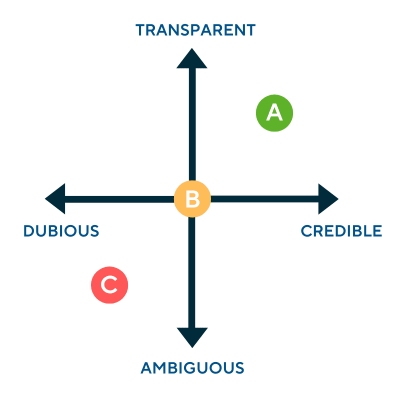Confusion and Ambiguity
Aligning to a Net Zero target accurately can be a real challenge. There is lots of mixed messages around guidelines and regulations on what a company should and shouldn’t include when measuring and reducing their carbon. This is not helped by the influx of companies in the carbon solutions market offering quick-fixes, basic online assessments, and unreliable data measurement requirements. Much of this only adds to the confusion, ambiguity, and lack of credibility in this space which naturally causes greater apprehension for companies to take real action.
The Harsh Truth
This concern is not unwarranted either. An increase in Net Zero commitments has triggered public attention, opening the space for public scrutiny. As more stakeholders are becoming aware of what makes a commitment ‘credible’, many have started asking questions about the exact detail of how companies are acting. The New Climate Institute for example have uncovered the reality of Net Zero commitments made by some of the world’s largest organisations and exposed some harsh truths. Ultimately, 25 of the world’s largest companies have pledged to reduce their emissions by 100% as suggested by their Net Zero claims, but in reality they are only committing to 40% reductions on average.
Sustainability Integrity Assessment
In this article we compare 3 companies who have made commitments to reducing carbon emissions but vary in terms of their sustainability integrity. For this article, integrity is defined by two criteria:
Transparency – How much detail does a company share publicly about their sustainability commitments?
Credibility – How detailed and robust are the methods, techniques and data?
Each company is based on public information, but all 3 organisations are kept anonymous so to not name or shame:
Company A – High Integrity
Company B – Medium Integrity
Company C – Low Integrity

Transparency: Pledge Assessment
Ambitious-sounding headline claims all too often lack real substance. Misleading climate statements lead to accusations of greenwashing that can have a negative impact on consumers, stakeholders, and the natural environment itself. Any pledges made should clearly show the regulations, guidelines, and third-party verification utilised to demonstrate real transparency.
Company C
This company has communicated their ambitions, with a special note to reach Net Zero. Their pathway to achieve their goals has been shared but is generic with very few specific objectives. Promotional activity however has been widespread, and public references to their pledges are listed clearly across their communications but without substantiating their claims leading to greater confusion. A Net Zero target alone is of very little use and only provides more questions than answers.
Company B
Promotional activity around this company’s carbon footprinting commitments includes a short public reference to their sustainability approach and pledge to Net Zero. The communication has been considered but the detail as to what’s included in their sustainability plans are limited. It may be that the company has just started their sustainability journey but not set out any clear plans to how they intend to tackle their carbon footprint. This means the company are constrained by what they can confidently communicate as their roadmap is not evident and lacks any short or long-term targets.
Company A
This company has displayed their commitments across all their public channels. This includes their impact report, website, and social media. They fully communicate their commitments including an outlined roadmap of how they aim to achieve their targets, complimented by the actions they have taken so far to make change happen effectively. They have also made clear on who they have partnered with including any third-party certification achievements that makes sure their actions are credibly implemented.
Credibility: Data Assessment
For a sustainability strategy to truly demonstrate integrity, it must be backed by credible data. With wishy-washy pledges and dubious data, organisations can make very little progress with their Net Zero goals. However, companies are starting to show more accountability within their data as more priority is placed on recording accurate information as external pressures mount. Yet some are still apprehensive to get started without a more uniformed approach to a Net Zero pathway.
Company C
The data is unclear. When reviewing their ambitious Net Zero target, this company have unfortunately not been able to demonstrate how exactly they will reach their target. There are a few examples of the right terminology, showing that only some consideration into what is needed has happened and there are no specific emission reduction commitments for their Net Zero target year. Company C also haven’t considered any intensity ratios that account for how the company might change in the future or how they could compare against their competitors.
Company B
This organisation has made a good attempt to demonstrate detail. With some insight into what carbon emissions they are looking to reduce, they have clearly set out on a path to decarbonise where possible. However, this is only for their Scopes 1 & 2. They would have a stronger strategy if they could outline how they plan to incorporate their Scope 3 into their reduction strategy. This organisation also hasn’t shown any consideration towards any necessary offsetting requirements for when they have reduced as much as they can.
Company A
Company A have done all that they can to showcase the detail of their Net Zero strategy. They example what a strong sustainability strategy looks like, with a clear and coherent roadmap to decarbonising their emissions. A Net Zero target has been set, but more importantly all reductions include direct and indirect, and all up and downstream emissions sources. That means Scopes 1, 2 & 3 have been covered and all their measurements are shown to be in-line with the highest international standards such as PAS2050, ISO 14064, and the GHG Protocol. They have also been certified for their first steps to reach Net Zero by Natural Carbon Solutions to make sure everything has been third-party verified.
A Foolproof Net Zero Pathway
Good intentions are one thing, but they will be short lived if companies don’t demonstrate greater sustainability integrity. By applying an open and transparent approach, you are not claiming to have all the answers but are establishing where your starting point is. Then by setting out a credible Net Zero pathway you are aligning your targets with the highest standards so that your strategy is foolproof. It can be challenging to know where to get started but concentrating on these two factors will put you in good stead and give you a greater chance of achieving your Net Zero target.
Are You Really on Track for Net Zero?
If you have started making commitments and taking action on your Net Zero pathway but are not sure how your strategy stacks up, we’ve designed this quiz for you. With these short 5 questions, you’ll get to understand whether your carbon reduction efforts meet the highest standards.





